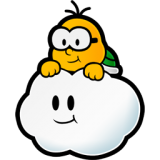History of Baseball Video Games #3 - Atari 2600's Home Run
By jbn566 7 Comments
This is a series of blogs based on my own personal game collection. I will attempt to go through them in a chronological order according to their release date. I will also attempt to play then on their original platform using the original controllers the game was designed for. If I am unable to get the system or the game working then I will use PC emulation or another platform emulation like the Intellivision Lives! game for the gamecube
Previous entries
1. Videocart 12 - Baseball (1977)
2. Astrocade's Tornado Baseball (1977)
---------------------
Home Run for Atari 2600, released 1978
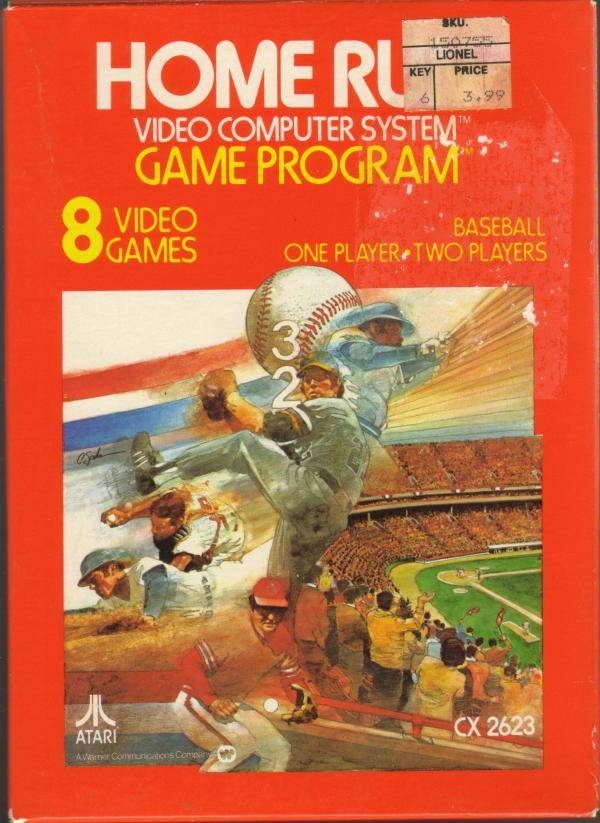
I am a little ashamed to admit I am missing the AC adaptor for two of my Atari 2600 systems. How can I call myself a collector of video games and not even own a fully working Atari 2600? With that said having 5 joysticks,2 pairs of paddle controllers, keypad controllers as well as a worn out Atari 2600 system retail box helps me sleep at night. In order to play any of the 2600 games I just dust off my working Atari 7800. The 7800 was able to play all 2600 games. Don't think Nintendo was the first to do this sort of thing with the Wii and Gamecube. This was occurring in the late 70's. Once I hooked everything up, my TV screen became my own personal baseball stadium. Now let’s hit a home run.
Graphics
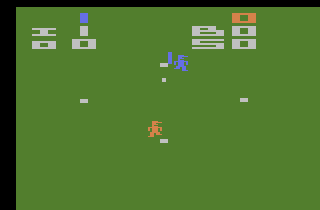
After you select one of the modes of play in typical Atari 2600 fashion pressing the reset button starts the game. The background is green and two baseball players are displayed. This game is a one on one baseball game and compared to other baseball games released during this time is by far the basic in terms of number of graphical elements. I started the game by pitching the ball from the center to the top of the screen. This 'up' direction of the baseball pitch is different from all previous baseball games. The batter does not move when swinging; only the bat, the bat is a vertical line. There are no other fielders besides the pitcher. The bases are just small lines and the game info text is so big that it is hard to determine what it is and takes up 1/3 of the top of the screen. There is also no graphical transition during the half innings. After every out the screen is reset with the pitcher in the center, after the third out the colors of players change. I found this to be confusing while playing, I guess I only have myself to blame for not knowing how many outs there were at all times. One second I was pitching and the next second a pitch was coming towards me.
Players

This is the first game that I recall where the players are wearing baseball hats, so hats off to Atari for adding that level of detail. With the addition of baseball bat this is the first time in a baseball video game that we know which way the players are facing. It is amazing what a difference a little line on the top of a pixel body adds to the player. All this new details on the players come at a cost. There is very little in terms of animation on the screen. The player only has two different looks; one facing left and the other one facing right. We still get the 'sliding' effect but now the heads are facing the direction they are moving. There is still no separation in terms of the player model. The players are still in one solid color but now this includes their hat; red for defense; blue for offense.
Field
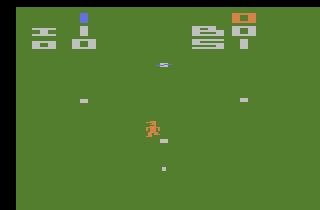
What field? There is no excuse for not having a field, even in 1978 when games from last year included them. The game takes a step back in this area and we all know with video games, never take a step back in graphics. I guess this game either proves how weak the Atari 2600 is in terms of technology or how rushed developers were in bringing a baseball game to the system. The field in this game consists of four small rectangles; home plate looks like all the other bases. There are no foul lines or batter boxes. The game info is just there on the top and sort of gets in the way of the game play. I look forward to a more standard way to display game time information . Home Run uses single capital letters for their stats; "I" is for innings, "O" is for out, "B" is for balls and "S" is for strikes. Yes "S" does look like a 5.
Fans
There isn't a field… There aren’t even nine players on the field. Rendering fans on the screen was probably not even discussed in planning meetings. Back then there weren’t many meetings to begin with as the developers only consisted of one or two people. Of all the graphical aspects of the game I wasn't going to put money on Atari revolutionizing the crowd/fans aspect of the game.
Home Run Celebration
When I first starting to play this game and thinking about this blog, I was to trying to determine how to write it. I thought for sure this was more of a home run derby game and less of a full game of baseball. You can’t really blame me can you? The title of the game was 'Home Run’ and the first screen was just a pitcher and a batter. As much as the graphics were underwhelming for a full baseball game I don’t think I would have felt this sad about it if it was a home run derby game. I make this point to drive home how truly underwhelming the home runs were in this game. Not only were they hard to come by but the action on the screen was no different than a double or single. A home run is only recorded as such if the ball travels directly through the center of the baseball diamond, past second base without the defense touching the ball. If it does not this; if it travels a little off center it is recorded as a double. During the home run you do see the base runner touch all the bases but with Atari 2600 flickering it is not very exciting to watch or perform.
Camera/Screen
There is only one screen in this game which besides the fairchild baseball game’s inning screen, This is turning out to be pretty standard way of producing baseball games in the late 1970’s. Also like previous games in the late 70's, The perspective is not the same for all the aspects. The field is rendered from a bird's eye view as well as the ball and bat but the players are not shown from the top but rather from the front. What makes it odder is because the batter only faces right when batting it and appears as though he is looking away from the ball. I never was good enough to make it out of little league I did learn that if you don't keep your eye on the ball as you swing you will never hit it.
Sound
If you never played an Atari 2600 system, you have no idea what you are missing. This game adheres to the grand Atari 2600 tradition of using computer beeps as sound. There are slightly different pitches to the beep but that is pretty minor. When the players move, the beep is used for each foot; each step the player takes. This might be the first baseball to attempt to do sound for the player movement, but I might prefer the silent smooth animation of the Astrocade baseball game to a beeping flickering animation of my player in Atari’s Home Run. There is no overall background sound or intro sound. There is also no sound effect when the inning ends or when the game is over.
Gameplay Modes
This is the first baseball game for the home consoles that have more than just one mode. To be honest that is a little stretch to call these play modes. Yes there are a total of 8 modes but each mode only changes the number of fielders you have in the game. This game only supports single games.
 | 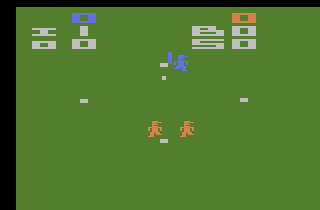 |
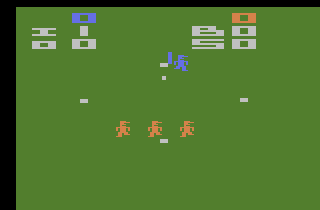 | 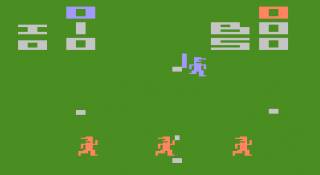 |
Mode 5 through 8 are two player modes 1 through 4.
Gameplay – Defense
One of the great innovations of this game has to be the ability of the player to have full control of the defense during the complete process of the putout. Prior games you controlled only the outfielders and anytime the ball touches the outfielder the ball is considered out. In Home Run, there is no outfield and all batted balls are more or less considered grounders and it is your job as the player to get the ball and run to the base for the force out or tag a base runner. We will hopefully start to see this game play mechanic in future baseball games. Some would say it is too easy to tag players out in this game. Luckily the Atari 2600 has a difficulty switch which in the game slows down the speed of the fielder compared to the base runner.
Gameplay – Offense
Once again in grand 1970 tradition, baseball video games don’t offer much control on the offense side of things. Home Run does stand out for adding one additional control besides swinging the bat and that is stopping your base runner from not advancing. Because of the new mechanic of every play is a ‘rundown’ It is only far if you can have control if you want to go for extra bases on a past ball. This is handled by pressing the one button found on the controller before your base runner reaches the next base.
Rules of Baseball
Home Run fails to put nine players on the field. It does play nine innings and batter’s count is correct. It even adheres to the rule of if batter is hit by pitch a free base is taken. When involved in a rundown the fielder only needs to touch the base for the force out or tag the player. This is a new element of the rules they nicly managed to include. The one aspect that is missing is the ability to throw the ball to base for the force out. It is missing because you only have one fielder and no other person to throw the ball to. You are able to perform a double play and I see no reason why a triple play cannot be preformed but chances of you managing to pull that off are very rare; only slightly more rare then witnessing a triple play in actual baseball.
Video Game Innovations
- One player mode,can play against the CPU
- Ability to control a fielder after catching the ball
- Fielder can perform a rundown and tag base runners out
- Baseball played with home plate near top of the screen and outfield towards the bottom
- Sound effect for fielder movements
- Baseball hats on players, first step in rendering baseball uniforms
